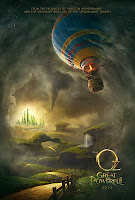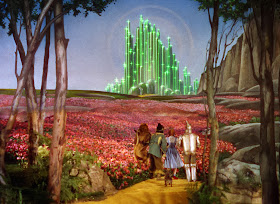 So, 2013 has presented us twice with Oz movies to see in 3D. And I went to see both in theaters. The first was, of course, Disney's Oz the Great and Powerful, which was filmed with the intention to be shown in 3D. Director Sam Raimi wisely chose not to have a lot of "in your face" 3D moments. Yes, flying baboons fly straight at the viewer, but largely, the 3D added depth to the world of Oz and made it draw viewers in more.
So, 2013 has presented us twice with Oz movies to see in 3D. And I went to see both in theaters. The first was, of course, Disney's Oz the Great and Powerful, which was filmed with the intention to be shown in 3D. Director Sam Raimi wisely chose not to have a lot of "in your face" 3D moments. Yes, flying baboons fly straight at the viewer, but largely, the 3D added depth to the world of Oz and made it draw viewers in more.And I don't know if it was certain techniques or beginning the film in black and white and subtle 3D, but the effect didn't bother my eyes. I did not go to bed with a headache.
But in late 2012, Warner Brothers announced that the MGM classic The Wizard of Oz would be restored once again for a 3D version to be released to 3D Blu-Ray. At the time of announcement, I hoped that they would release it for at least a limited release in theaters. Well, only a few months ago, they announced that that would be the case. It would play nationwide in over 300 IMAX theaters. Screening events have been announced for other countries, though they don't seem to have received a lot of press.
Making a 3D version of a classic film has proved controversial to film fans. It is, admittedly, retrofitting an old film for a modern market trend. However, The Wizard of Oz is a visually rich film. Perhaps such a conversion would not be such a bad thing. And in any case, it would not replace the original version, but only be a different way to view it.
Today is the fourth of the seven days that you can go see it at a theater and the day I finally went to see it myself. It was also the first time I've been to an IMAX theater. I was actually the first customer there, arriving before the doors were unlocked. (Six other customers for Oz would follow.)
I've seen the MGM movie on a big screen before, but it was a screen on the smaller end of projection screens, and it seemed to have been a tired, faded film print. While the screen I saw today wasn't a legendary huge IMAX screen, it was definitely bigger than any other screen I'd seen.
Some have noted seeing no film grain on the picture, but I noticed it in its full glory as soon as Judy Garland and Terry appeared onscreen. Most people had thought the 3D conversion would reduce the film grain and make everything look waxy, but it was delightfully not the case. The film looks as great as it ever has, just now in 3D.
A word on film grain: it is very much a good thing. Prior to Blu-Ray, you didn't really see film grain at home due to low resolution on very much every home video format. High definition, however, can show the fine details of a film transfer. The image is in the film grain, because that is what makes up the image on the film. The Wizard of Oz was shot on film and in Technicolor and should look that way. Film grain can be removed digitally, but the result looks glossed and unnatural.
Rather than try to make the 3D really pop out of the screen, the people behind the conversion wisely just broke the image into layers, accurately spacing them apart to give the properly-spaced illusion of depth. Even the matte paintings that turned the empty space of the MGM studios into the spectacular Land of Oz were broken into 3D landscapes. This is a case where less is more.
The depth shown allows viewers to recognize more detail (though the huge IMAX screen and a 4k film transfer definitely help as well) in the film. For the first time, I noticed that when we first see the Winkie guards, two of them are beating drums and one is sounding a pair of cymbals. However, we only hear the drums on the soundtrack. Sharon Ray notices that Dorothy curls Toto's hair at the Wash and Brush Up Company. And that's definitely a bird and not a suicidal Munchkin! Who knows what else has been eluding us all this time?
After Thursday, the only way to see The Wizard of Oz in 3D will be in the new 3D Blu-Ray. And since the last time I posted about it, some new details have come to light about this release and its four home video editions.
Codes for a Ultraviolet version of the movie will be available with some if not all editions. Ultraviolet is a service that allows you to stream movies to TVs, computers, and mobile devices for free through certain vendors, including my favorite Vudu. (Disney titles are not available on Ultraviolet, but Oz the Great and Powerful and Return to Oz can be purchased on Vudu, so you could watch all three in a marathon.)
The DVD edition is a single disc version and will probably be very similar to the first disc of the 2009 DVD editions. Possibly features from that version will be dropped to make room for the new 1-hour documentary about the making of the movie.
If you still haven't gone to Blu-Ray or don't want the new 3D version or just want to see that new documentary, this is likely the one to pick up.
It is unknown if the Ultraviolet version will definitely be included with this one, though I'd be surprised if it didn't.
The Blu-Ray standalone release is also a one-disc affair this time around. Early reports say that this is a re-authored version of the first disc of the 2009 Blu-Ray editions with the new documentary added.
 The drop of the second disc from the 2009 Blu-Ray sets is a little sad, meaning that if you want that disc, you have to hunt for one of those or go for the "big box" edition.
The drop of the second disc from the 2009 Blu-Ray sets is a little sad, meaning that if you want that disc, you have to hunt for one of those or go for the "big box" edition.It also hasn't been confirmed if the Ultraviolet copy will be included on this.
The 3D Blu-Ray copy is a 2-disc version, featuring the 3D version on a disc and the above Blu-Ray standalone disc is one case. This will also be available from Best Buy in a steelbook case. Other retailer exclusive editions have been confirmed, but will only differ in packaging, not content.
Early photos of this edition confirm that the Ultraviolet code will be included here.
This year's "big box" edition contains five discs: the 3D Blu-Ray, the standalone Blu-Ray, a third Blu-Ray of special features re-released from the 2009 sets, the standalone DVD, and the dual-sided DVD of the documentary MGM: When the Lion Roars. Personally, I would have liked it better if they had put this on a Blu-Ray with some new bonus features. (I'm already suggesting that next time
they dig up wraparounds that were used for early TV broadcasts.) Also, you get the Ultraviolet code. The discs will come housed in a standard case, meaning that you can take it out, put it on the shelf with your other normally-packaged Blu-Rays and put the big box into storage.
The 1999 deluxe release of the DVD came with a reproduction of the movie's script. The 2005 Collector's 3-disc edition DVD came with reproduction 1939 Kodachome photos, a premiere ticket and program, MGM studio news and the Photoplay Studies guide, and a card showing tiny images of 1939 posters. The 2009 Ultimate Collector's Edition came with a watch in a tin, a 52 page book by John Fricke, and reproductions of the film's budget and campaign book.
 |
| Photos courtesy of Zachary Ryan Allen |
So, head on out and take in the classic MGM film in 3D while you can, decide if you want to take it home on 3D Blu-Ray, even if you don't have a set up yet.

































